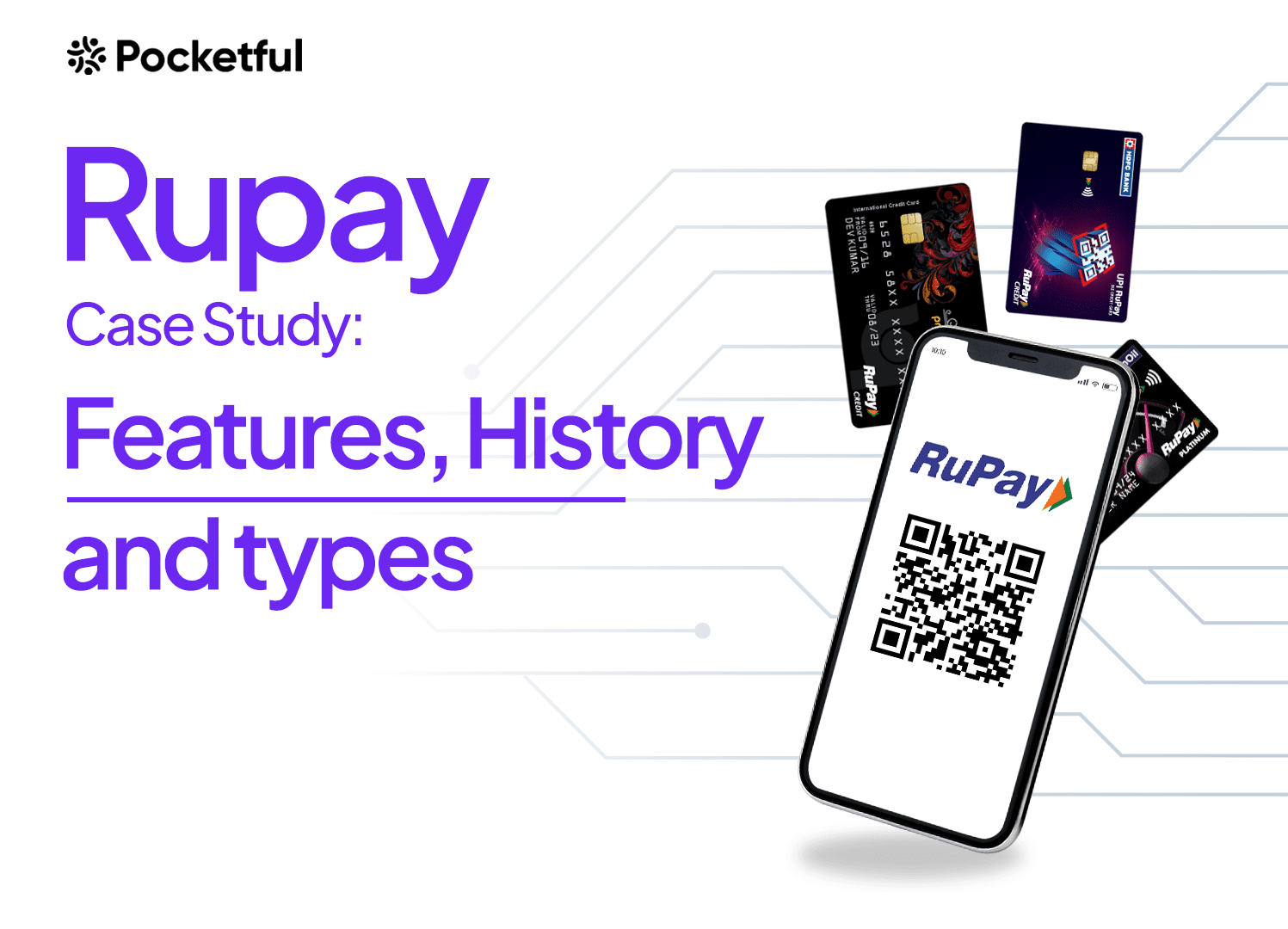| Type | Description | Contributor | Date |
|---|---|---|---|
| Post created | Pocketful Team | Mar-23-24 | |
| Add new links | Nisha | Mar-12-25 |

- Blog
- rupay case study features timeline types growth and comparison
Rupay Case Study: Features, Timeline, Types, Growth, and Comparison

Payment merchants like Visa and Mastercard have just gotten major competition from our homegrown merchant, Rupay.
We have all heard about Rupay, but very few know its story. Read this blog to learn more about its characteristics.
Overview Rupay
India developed the Rupay payment service system in 2012 to substitute for global payment networks like Visa and Mastercard. Rupay is a combination of “Rupee” and “Payment.”
It operates in both Debit and Credit card segments and facilitates cardholders in making online transactions at different merchants and ATMs nationwide.
Features
- Target Audience – Rupay Card’s primary target is the domestic market, which aims to reduce reliance on foreign payment systems.
- Cost Efficient – The Rupay facilitates transactions with online merchants, retailers, etc., at a significantly lower cost.
- General Acceptability – Almost all merchants and online platforms accept the card.
- Security – The cards issued by Rupay are secured with EMV chip technology and two-factor authentication, which makes them much more secure.
- Partnership – NPCI has collaborated with various financial institutions and banks to expand their network. They have partnered with domestic institutions and international networks.

Timeline
2009 – The Reserve Bank of India realised there should be less dependency on the international payment system.
2014 – NPCI launched a credit card network in collaboration with various Indian banks.
2021 – NPCI collaborated with Kotak Mahindra Bank to launch a special credit card for the Indian Armed Forces. It also launched co-branded cards with several banks like Union Bank, Federal Bank, etc.
Did you know?
Rupay is the 7th payment network in the world after Visa, Mastercard, American Express, Discover, Diners Club, and JCB.
Issuing Banks
This card is currently issued by around 1100 banks, ranging from cooperative to regional rural banks and public to private sectors.
Bank of India, Union Bank of India, Canara Bank, Bank of Baroda, State Bank of India, ICICI Bank, HDFC Bank, Citibank, and HSBC Bank are the primary promoter banks of the Rupay card.
Growth of Rupay
Since its introduction, the Rupay card has experienced exponential growth, surpassing Visa in 2017 in terms of transaction volume. Additionally, between FY 2017 and FY 2022, their debit card sector grew at a rate of more than 40% CAGR.
There has been a strong trend in credit card growth. In December 2023, the total volume of credit card transactions surpassed the 10,000 crore mark for the first time. It accounted for approximately 6% of domestic credit card transactions, and by December 2023, about ten million credit cards had been issued by Rupay.
Read Also: IndusInd Bank Case Study: Business Model, Product Portfolio, and SWOT Analysis
Types of Rupay Cards
The cards issued can be divided into different categories-
Function
1. Credit Card – The bank that issued this Rupay card gives you a credit limit that you can use and then pay back to the bank after some time.
2. Debit Card – This is an individual’s most commonly used card. It allows you to spend the money in your bank account.
3. Prepaid Card – This card needs a periodical recharge from a particular vendor, after which you can use it until its limit exhausts.
4. Special Purpose Card :
- Rupay Kisan Card – This card is designed to cater to the needs of the farmers. Through it, farmers can receive government subsidies.
- Rupay Jan Dhan Card – This card is issued under Pradhan Mantri Jan Dhan Yojna to provide financial services to low-income groups of people.
Facilities
1. Classic – This type of card bank issue has basic facilities such as ATM withdrawal and online payment.
2. Platinum – This type of card possesses some other features like airport lounge access, cashback offers, rewards points, etc.
3. Customized – This type of card is issued according to the utility of the customer.

Comparison of Rupay, Visa, and Mastercard
Although Visa, Mastercard, and Rupay all provide comparable services, there are differences between them in terms of features and target customer base.
Costing – Rupay cards have lower annual fees than Visa and MasterCard as they charge fees based on the card’s features.
Types of Card – Rupay offers debit, credit, and prepaid cards, but its credit card network is still growing. On the other hand, Visa and MasterCard provide corporate cards and have a wider network of credit cards.
Support System – Visa and MasterCard have a wider range of support systems, while Rupay is still developing.
Rewards – Visa and Master cards provide numerous benefits, from cash back to rewards points and travel miles to extended warranties. On the other hand, Rupay has fewer reward points than them and generally offers cashback and discounts.
Read Also: Hero MotoCorp Case Study: Business Model and SWOT Analysis
Conclusion
Since its establishment in 2014, Rupay has swiftly risen to prominence within the global payment landscape, posing a strong challenge to established giants such as Visa and Mastercard in just ten years. Distinguished by its laser-focused approach to the domestic market, Rupay has carved a niche for itself through its cost-effective operations, extensive acceptance network, and stringent security measures, propelling its meteoric rise. Surpassing Visa in transaction volume, Rupay has witnessed exponential growth across the debit and credit card sectors.
Through strategic alliances with many financial institutions and banks, Rupay has not only influenced the payment processing industry but also diversified its suite of services to cater to the unique needs of various demographics, including farmers and economically disadvantaged groups.
Frequently Asked Questions (FAQs)
Which company established Rupay?
National Payment Corporation of India (NPCI) established Rupay.
When was Rupay launched?
Rupay was launched in 2012.
Which country accepts Rupay?
The countries that accept Rupay are Bhutan, Nepal, Mauritius, Singapore, and UAE.
What is the full form of Rupay?
The word Rupay is a combination of two different words “Rupee” and “Payment” which means India’s card payment system.
Which merchant should I choose for my credit card?
All payment merchants provide separate benefits. It is recommended to perform your own analysis to find out which merchant is better suited for you.
Disclaimer
The securities, funds, and strategies discussed in this blog are provided for informational purposes only. They do not represent endorsements or recommendations. Investors should conduct their own research and seek professional advice before making any investment decisions.